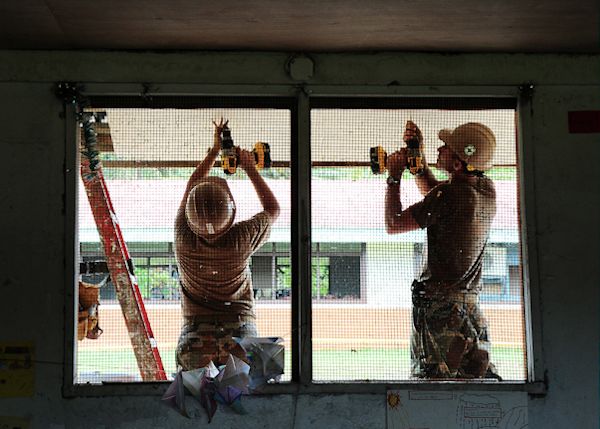SEJournal Online is the digital news magazine of the Society of Environmental Journalists. Learn more about SEJournal Online, including submission, subscription and advertising information.
 |
| Some construction materials like plywood and particleboard use resins containing the carcinogen formaldehyde. The Pharos database helps assess the hazards of such building materials and chemicals. Photo: U.S. Air Force/Tech. Sgt. Tony Tolley, Flickr Creative Commons. Click to enlarge. |
Reporter’s Toolbox: Building Materials Data Can Help Construct Environmental Stories
By Joseph A. Davis
Building materials are a major part of our environment, but not always in a good way.
In fact, some materials, whether in commercial structures or our homes (subscription required), are downright toxic, exposing people to everything from volatile organic compounds, or VOCs, which can act as neurotoxins, to the carcinogen formaldehyde or the class of industrial chemicals known as PFAS.
To help cover the problem, environmental journalists might want to know about a database revealing the many ways that building materials can be hazardous.
It amounts to a lot of data — and potentially a lot of stories.
The database is called Pharos and is a project of the nonprofit Healthy Building Network. The initiative is to a large extent foundation-funded and free (sign up for an account), although heavy users can get paid professional accounts with more functionality.
Where the data comes from
The stated goal of Pharos is both to assess the health hazards of building materials and chemicals and also to find safer alternatives.
And in doing so, the massive database provides “hazard, use, and exposure information on 164,042 chemicals and 155 different kinds of building products.”
Pharos gathers all this information together by integrating data from many standard lists of hazardous materials (see the full list once you’ve signed in).
So, for example, most of the lists on the U.S. Environmental Protection Agency’s EPCRA/CERCLA “Consolidated List of Lists“ have been taken into account (although not all the substances on them are used in building materials).
There are also lots of special-use lists pertinent to construction. Many are from foreign countries or international bodies. Want to know about a substance on California’s Prop 65 list? They’ve got you.
What’s different is that some of these sources may not immediately tell you, for example, all the things that go into wallboard … or joint compound or joint tape. Pharos does.
Some of the sources are specialized in useful ways (e.g., all the things that can trigger asthma). Documentation and description of the data sources is transparent and useful.
How to use the data smartly
As databases go, Pharos is very functional and can do a lot. Of course, it is online and searchable. It is accessible to laypeople as well as builders and engineers. And, importantly, its features actually work.
Pharos allows you to set up comparisons
for side-by-side evaluation of the
hazards of alternative materials.
Not only that, but it allows you to set up comparisons for side-by-side evaluation of the hazards of alternative materials. This might allow either a builder or a journalist to check on which materials are safer or more dangerous.
Pharos also allows users to engage in community discussions, which can be organized by topic, and it allows you to participate in these as much (or as little) as you like.
And data-journalism geeks will be happy to learn that it allows you to download the datasets it produces in spreadsheet form so you can play with them however you want.
It’s not perfect. It will tell you about peppermint oil — but not about lead drinking water pipes. Or even copper drinking water pipes.
Possible story ideas
Just to incite your imagination, we offer a few story ideas as an example of what could be done with this database.
- Does the building in question use particleboard or plywood? Does formaldehyde go into making it?
- Does a building use concrete sealant? What goes into it? Could it be toxic?
- Does a building contain materials with polyvinyl chloride? What risks does it present?
- Has methyl bromide been used in connection with a building? What are the hazards and what might exposure be?
Joseph A. Davis is a freelance writer/editor in Washington, D.C. who has been writing about the environment since 1976. He writes SEJournal Online's TipSheet, Reporter's Toolbox and Issue Backgrounder, as well as compiling SEJ's weekday news headlines service EJToday. Davis also directs SEJ's Freedom of Information Project and writes the WatchDog opinion column and WatchDog Alert.
* From the weekly news magazine SEJournal Online, Vol. 5, No. 26. Content from each new issue of SEJournal Online is available to the public via the SEJournal Online main page. Subscribe to the e-newsletter here. And see past issues of the SEJournal archived here.













 Advertisement
Advertisement 



